Guided Interpretive Workshops
Granite Park Chalet is uniquely suited for naturalist outings led by trained experts with many years of experience in Glacier National Park. Few other places in North America afford the opportunity provided by the Chalet's location for park visitors to experience first hand the natural world in an unbroken ecosystem.
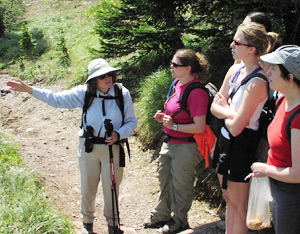
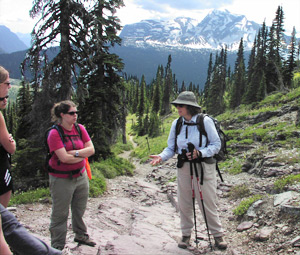
Janet Paul Bones teaching on the trail near
Granite Park Chalet.
2024 Operating season and workshop schedule:
| June | ||||||
|---|---|---|---|---|---|---|
| Sun | Mon | Tue | Wed | Thu | Fri | Sat |
| 1 | ||||||
| 2 | 3 | 4 | 5 | 6 | 7 | 8 |
| 9 | 10 | 11 | 12 | 13 | 14 | 15 |
| 16 | 17 | 18 | 19 | 20 | 21 | 22 |
| 23 | 24 | 25 | 26 | 27 | 28 | 29 |
| 30 | ||||||
| July | ||||||
|---|---|---|---|---|---|---|
| Sun | Mon | Tue | Wed | Thu | Fri | Sat |
| 1 | 2 | 3 | 4 | 5 | 6 | |
| 7 | 8 | 9 | 10 | 11 | 12 | 13 |
| 14 | 15 | 16 | 17 | 18 | 19 | 20 |
| 21 | 22 | 23 | 24 | 25 | 26 | 27 |
| 28 | 29 | 30 | 31 | |||
| August | ||||||
|---|---|---|---|---|---|---|
| Sun | Mon | Tue | Wed | Thu | Fri | Sat |
| 1 | 2 | 3 | ||||
| 4 | 5 | 6 | 7 | 8 | 9 | 10 |
| 11 | 12 | 13 | 14 | 15 | 16 | 17 |
| 18 | 19 | 20 | 21 | 22 | 23 | 24 |
| 25 | 26 | 27 | 28 | 29 | 30 | 31 |
| September | ||||||
|---|---|---|---|---|---|---|
| Sun | Mon | Tue | Wed | Thu | Fri | Sat |
| 1 | 2 | 3 | 4 | 5 | 6 | 7 |
| 8 | 9 | 10 | 11 | 12 | 13 | 14 |
| 15 | 16 | 17 | 18 | 19 | 20 | 21 |
| 22 | 23 | 24 | 25 | 26 | 27 | 28 |
| 29 | 30 | |||||
Alpine Wildflowers
High Alpine Ecology
100 Years at Granite Park... and Beyond!
Geology of Ahern Pass
Geology of the Granite Park Area
Art in the Granite Park Alpine Environment
Mountaintop Megafauna
2024 Schedule
Alpine Wildflowers
July 8 and 9
July 9 and 10
100 Years at Granite Park... and Beyond! A Natural History Exploration for Families.
July 14 and 15
July 17 and 18
High Alpine Ecology A Natural History Exploration for Families.
July 15 and 16
July 18 and 19
Geology of the Granite Park Area
July 22 and 23
July 25 and 26
August 12 and 13
Geology of Ahern Pass
July 23 and 24
July 26 and 27
August 13 and 14
Art in the Granite Park Alpine Environment
August 9 and 10
August 10 and 11
Mountaintop Megafauna
Goats, Grizz, and Wolverines
August 23 and 24
Each Workshop includes:
- Introductory evening overview session.
- All day interpretive workshop, highlighting specific features in the heart of Glacier National Park's unequaled scenery!
- Wrap up evening session to be enjoyed by all.
- Complimentary large bottle of water and snack provided.
Costs:
$120.00 per person in addition to the required two night chalet reservation.
Space is limited and reservations are required.
All workshops take place rain or shine.
Cancellations
- Full payment for any interpretive hike is required within two weeks of booking and in advance of the chalet stay.
- Deposits for canceled interpretive hikes will be refunded if the reservation is filled by another guest.
- The charge for a canceled workshop is non-refundable if we are unable to re fill the vacancy.
To reserve your space or for more information, call the Granite Park Chalet reservation office: 1-888-345-2649
Alpine Wildflower Workshop
Join a former National Park Service naturalist for an alpine wildflower experience with outstanding mountain scenery all around. Observe physical factors of the environment to which alpine plants have successfully adapted. Rubber roots, hairy stems, underground flower buds, solar collecting flower blossoms, mature plants, growing young plants, and cushion and rosette growth forms, all enable these wonderful plants to survive in this beautiful, but harsh landscape.
Depending on the flowers in bloom, Swiftcurrent Fire Lookout Trail, or the Grinnell Glacier Overlook will be used to view the rocky alpine species. Both of these trails gain approximately a thousand feet in elevation. Since we are identifying plants and flowers the walking pace is slow.
Hand lenses are nice to have. A few lenses may be borrowed. A simple identification key will be provided for use during the workshop. Feel free to bring a favorite plant identification book if you have one.
Your guide will be Janet Paul Bones, a former ranger naturalist in Glacier National Park, a teacher and presenter for the Smithsonian Institute and the Glacier Institute. She has been teaching field classes in Glacier National Park since 1984. Her longtime commitment to education and her extensive experience in Glacier National Park make this an extraordinary opportunity.
Hiking Level: Moderate.
100 Years at Granite Park... and Beyond!
Come explore the human and natural environment of this important historic landmark.
Families and people of all ages are invited to come have some fun with veteran naturalist and educator Ashley Mason. This workshop will be truly "hands-on" as we explore the geology, mammals, birds and human history of the spectacular Granite Park Chalet area. Activities will be geared toward multi-age audience and will include demonstrations, games, songs and costumes. All are welcome as long as you are a kid at heart!
Participants will use cookies, slime and other interesting props to learn about Glacier's amazing geological history. The spectacular but sometimes harsh subalpine environment provides a fascinating backdrop to discuss survival strategies, behavior and adaptations of those plants and animals that live there. Finally, a walk around the Chalet area will reveal some of the more interesting human history of the area.
Depending on the weather the Swiftcurrent Trail, or the Ahern Pass Trail as well as the Chalet Loop Trail will be used for hikes and activities. These trails are easy to moderate in difficulty and the pace will be moderate to slow.
Evening programs will include a fun interactive program on Pikas, Glacier's high country rabbit species (with costumes!).
Ashley Mason is a former Glacier National Park ranger naturalist, as well as Audubon educator. She is currently an instructor for Road Scholar and The Glacier Institute and Flathead Valley Community College. In addition, she was the 2012 Audubon Educator of the Year. She has been teaching field classes in and around Glacier National Park since 1992. She has a passion for taking the amazing and often complex stories of the landscape and distilling them into compelling stories for her students. She is especially interested in making conservation education fun and accessible for families and people of all backgrounds.
Hiking Level: Easy to Moderate.
High Alpine Ecology
A natural history exploration for families.
Families and people of all ages are invited to explore the ecology of Glacier's high alpine with veteran naturalist Ashley Mason. Activities will be hands-on and geared toward a multi-age audience. All are welcome as long as you are young at heart!
A visit to Glacier's high country provides a truly unique opportunity to step back into the past... the ancient past. As recent at 10,000 years ago Glacier's mountain-tops rose from a sea of Glacial Ice. These high mountain environments still exist as natural-history museums preserving the fascinating story of the Park's ice-age past. The instructor will use a hands-on approach to explain local geology and how the glaciers scoured the landscape, making way for the unique plant and animal communities that live there today. The spectacular but sometimes harsh subalpine environment provides a fascinating backdrop to discuss survival strategies and behavioral adaptations of those plants and animals that are relics of the ice-age past such as the American Pika, hoary marmot and Columbian ground squirrel. We will also discuss how climate change is affecting those populations as well as Park research programs on climate change.
The course will cross the continental divide on the spectacular Swiftcurrent Trail, with the option of hiking to the Swfitcurrent Lookout. The sweeping and dramatic views of the peaks of Waterton National Park, Canada, to the north, the Blackfeet Indian Reservation to the east will be used as a backdrop for discussing Glacier's geologic history and identifying glacially carved features of the Park's landscape. These trails provide excellent wildlife viewing opportunities and are easy to moderate in difficulty. The pace will be easy to moderate.
Evening programs will include a fun interactive program on Pikas, Glacier's high country rabbit species (with costumes!), as well as a talk celebrating the Centennial of the National Park Service and its legacy of conservation.
Ashley Mason is a former Glacier National Park ranger naturalist, as well as Audubon educator. She is currently an instructor for Road Scholar and The Glacier Institute and Flathead Valley Community College. In addition, she was the 2012 Audubon Educator of the Year. She has been teaching field classes in and around Glacier National Park since 1992. She has a passion for taking the amazing and often complex stories of the landscape and distilling them into compelling stories for her students. She is especially interested in making conservation education fun and accessible for families and people of all backgrounds.
Hiking Level: Easy to Moderate.
Art in the Granite Park Alpine Environment
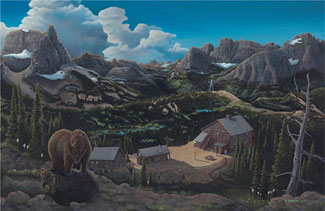 Glacier's surreal beauty and mysterious wonders have been inspiring artists for thousands of years. Experience the Park through the eyes of an artist, as you capture the breathtaking scenery around Granite Park Chalet through watercolor painting. During this workshop, you will enjoy relaxing painting lessons from an accomplished artist, while learning to work in the unpredictable environment of Glacier National Park. This workshop will take place mostly within the compound of the Chalet, but since every artist sees the world differently, subject matter will be determined by you. We will begin the day with a quick painting exercise to get in the mindset of an artist. We will use these exercises to explore the difference between what we see and what we feel, and learn to use each in a final painting. From there, we will begin working on our piece for the day. We will start by learning how to construct and frame a drawing accurately, using and understanding scale and composition. From there, we will jump into painting. We will begin with instruction on how to see and capture light and shadow as another method of developing composition. As we develop our paintings, you will learn different ways to build clean and unique washes, create texture with brush strokes, learn about color, and acquire the ability to study light and shadow in order to capture the drama it imposes on a landscape. Following the nightly lecture, weather permitting, we will also have the option of going on a quick hike to Sunset Ridge, and paint in the evening.
Glacier's surreal beauty and mysterious wonders have been inspiring artists for thousands of years. Experience the Park through the eyes of an artist, as you capture the breathtaking scenery around Granite Park Chalet through watercolor painting. During this workshop, you will enjoy relaxing painting lessons from an accomplished artist, while learning to work in the unpredictable environment of Glacier National Park. This workshop will take place mostly within the compound of the Chalet, but since every artist sees the world differently, subject matter will be determined by you. We will begin the day with a quick painting exercise to get in the mindset of an artist. We will use these exercises to explore the difference between what we see and what we feel, and learn to use each in a final painting. From there, we will begin working on our piece for the day. We will start by learning how to construct and frame a drawing accurately, using and understanding scale and composition. From there, we will jump into painting. We will begin with instruction on how to see and capture light and shadow as another method of developing composition. As we develop our paintings, you will learn different ways to build clean and unique washes, create texture with brush strokes, learn about color, and acquire the ability to study light and shadow in order to capture the drama it imposes on a landscape. Following the nightly lecture, weather permitting, we will also have the option of going on a quick hike to Sunset Ridge, and paint in the evening.
Evening talks will explore the history of art in Glacier National Park, from traditional Native art, to the advertising of the Great Northern Railroad, Charlie Russell's Bull Head Lodge, and working contemporary artists. We will discuss and analyze the relationship between art, artist and Glacier Park.
Art supplies will be the responsibility of the guest. A supply list is available for anyone interested, but you can expect to get everything for approximately $25 or less.
Instructor Adam Grensten, is an awarded artist, former chalet employee, and is experienced in teaching art to all ages. At an early age, Adam gained a deep appreciation for nature and the wildlife that inhabits Montana. Eventually, this admiration of the natural world sparked an interest in art. After four summers spent working in and around Glacier National Park, he found his calling as an artist dedicated to capturing and understanding the natural world. In 2008, at age 19, Adam was awarded the title of Montana Ducks Unlimited Artist of the year. After four years at Montana State, Adam's art career has steadily flourished throughout Montana and Seattle. His work has been shown at many galleries including the Lewistown Art Center, The Spotted Horse Gallery, The Urban Lights Studio, The Full Circle Gallery, The Quadrapus, The Gasworks Gallery and The Eight and Sand Gallery. In 2014, Adam opened The M T Minded Gallery in Lewistown, MT. Adam has taught painting classes through the Adult Education Program in Lewistown, and was the Director of Art Education at the Lewistown Art Center in 2015. Here he gained experience teaching art to kid's ages 4-16.
He was selected in 2016 as one of the artists for the visual entertainment for Sasquatch Festival. Now, as a renowned muralist in Central Montana, Adam maintains his gallery presence online, while focusing on exploring new environments to continuously expand his love and understanding of nature. His friendly and easy-going demeanor, and knowledge of the Granite Park area will make this learning experience fun and rewarding.
Geology Workshops
The Geology Workshop comprises an evening orientation session on the Geology of Glacier National Park, two half-day field trips led by a trained geologist and a wrap up session in the evening. Instructor - Jeff Kuhn
Geology of Granite Park
 Originating at Granite Park Chalet, a morning field trip will take participants along the Highline Trail to the Grinnell Glacier Overlook to see a spectacular view of Grinnell Glacier, one the largest of Glacier Park's remaining glaciers. The group will hike along the great glacial arête that forms the crest of the Continental Divide - "the backbone" to Native Americans. The field trip will emphasize recent US Geological Survey research focusing on the rapid recession of Glacier Park's glaciers due to the current global warming trend. Grinnell Glacier is one of the largest remaining glaciers in Glacier Park and one of the best examples of glacial recession in the United States. The group will continue discussion on the unique Precambrian geology of Glacier Park and its place in the geologic development of the North American continent. A striking and well-exposed sequence of algal stromatolites (fossil algae), red and green argillites, and tan to gray dolomites of the Snowslip and Helena Formations, will be observed during the hike. Most geologists theorize that these rocks are good evidence that the earth's atmosphere was quite different during the Precambrian. An atmosphere rich in CO2 may have allowed for the growth of massive algal colonies such as those preserved in the Precambrian rocks of Glacier National Park. The group will also discuss plate tectonics and the importance of the Lewis Thrust Fault in Glacier Park's geologic history.
Originating at Granite Park Chalet, a morning field trip will take participants along the Highline Trail to the Grinnell Glacier Overlook to see a spectacular view of Grinnell Glacier, one the largest of Glacier Park's remaining glaciers. The group will hike along the great glacial arête that forms the crest of the Continental Divide - "the backbone" to Native Americans. The field trip will emphasize recent US Geological Survey research focusing on the rapid recession of Glacier Park's glaciers due to the current global warming trend. Grinnell Glacier is one of the largest remaining glaciers in Glacier Park and one of the best examples of glacial recession in the United States. The group will continue discussion on the unique Precambrian geology of Glacier Park and its place in the geologic development of the North American continent. A striking and well-exposed sequence of algal stromatolites (fossil algae), red and green argillites, and tan to gray dolomites of the Snowslip and Helena Formations, will be observed during the hike. Most geologists theorize that these rocks are good evidence that the earth's atmosphere was quite different during the Precambrian. An atmosphere rich in CO2 may have allowed for the growth of massive algal colonies such as those preserved in the Precambrian rocks of Glacier National Park. The group will also discuss plate tectonics and the importance of the Lewis Thrust Fault in Glacier Park's geologic history.
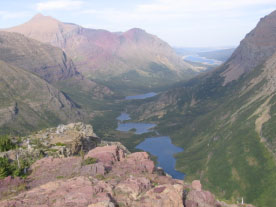 During the afternoon, our geologist will guide participants over the Precambrian basalt flows at Granite Park and ascend the Swiftcurrent Pass Trail to its highest elevation above the chalet where the incredible glacial landscape of the Upper Swiftcurrent Valley can be viewed to the east. The focus of this hike will be to observe the large lava flows visible in the area, and to gain a better understanding of the geologic forces that create glacial landscapes. The Purcell Lava represents an ancient sequence of volcanic pillow basalts deposited on the seafloor approximately one billion years ago. The group will discuss the environment of deposition of these unusual volcanic rocks and how they have come to be located at the crest of the Continental Divide in Glacier National Park. From the top of Swiftcurrent Pass the group will view the Swiftcurrent Glacier and learn to identify features of the glacial landscape sculpted by moving ice during the last Ice Age. Swiftcurrent Pass is an excellent vantage point for this discussion and also provides a good overview of Glacier's geologic history. The peaks of Waterton National Park, Canada, to the north, the Blackfeet Indian Reservation to the east, and the edge of the great overthrust, known as the Lewis Thrust Fault, can be seen from Swiftcurrent Pass. It is a spectacular view not to be missed.
During the afternoon, our geologist will guide participants over the Precambrian basalt flows at Granite Park and ascend the Swiftcurrent Pass Trail to its highest elevation above the chalet where the incredible glacial landscape of the Upper Swiftcurrent Valley can be viewed to the east. The focus of this hike will be to observe the large lava flows visible in the area, and to gain a better understanding of the geologic forces that create glacial landscapes. The Purcell Lava represents an ancient sequence of volcanic pillow basalts deposited on the seafloor approximately one billion years ago. The group will discuss the environment of deposition of these unusual volcanic rocks and how they have come to be located at the crest of the Continental Divide in Glacier National Park. From the top of Swiftcurrent Pass the group will view the Swiftcurrent Glacier and learn to identify features of the glacial landscape sculpted by moving ice during the last Ice Age. Swiftcurrent Pass is an excellent vantage point for this discussion and also provides a good overview of Glacier's geologic history. The peaks of Waterton National Park, Canada, to the north, the Blackfeet Indian Reservation to the east, and the edge of the great overthrust, known as the Lewis Thrust Fault, can be seen from Swiftcurrent Pass. It is a spectacular view not to be missed.
Jeff Kuhn will be your guide for this workshop. Jeff is a trained geologist and a long-time veteran of Glacier National Park. He has worked seasonal positions as a Back Country Ranger in the Belly River area, fought fires as a member of the Glacier National Park Hot Shot Crew, and worked as an employee at Many Glacier Hotel. Jeff is currently employed by the Montana Department of Environmental Quality as a program manager and hydrogeologist. We invite you to come and explore Glacier's awesome and dynamic natural world first hand with an experienced geologist.
Hiking Level: Moderate to strenuous.

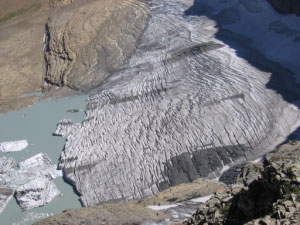
Geology of the Ahern Pass Area
The day hike from Granite Park to Ahern Pass, is approximately 10 miles round-trip. It covers a dramatic and beautiful stretch of the Highline Trail that continues north to Waterton Lake. There is a moderate elevation gain of 300 feet from Granite Park to the Ahern Pass spur trail, then an additional 400 feet to the incredible viewpoint at Ahern Pass. From the pass there are striking views of the Pinnacle Wall, Iceberg Notch, Ahern Peak, Helen Lake, and Belly River Country to the north. The geology along the trail is spectacular. We'll discuss the depositional environment of the Precambrian Helena, Snowslip, and Shepard Formations, and the formation of the extensive lava flows that the trail dissects for the first several miles, eventually arriving at the "algal reef" near Ahern Drift. The Climber's Guide to Glacier National Park (J. Gordon Edwards, 1984) often refers to the "algal reef", a prominent layer of fossil algae, known as "stromatolites" located in the Helena Formation. This layer of stromatolites represents a geologic marker bed widely visible throughout Glacier Park and is well known to climbers. At Ahern Pass we'll look down onto Ahern Glacier and discuss glacial flow, and glacial deposition, familiarizing ourselves with basic glacial terminology. We'll also discuss climate change and its profound effect on the glaciers of Glacier National Park. The group will depart from Granite Park Chalet at 8 AM to allow for return to the chalet between 5 PM and 6 PM. Bring good boots, rain gear, binoculars, and lunch for the all day hike.
Mountaintop Megafauna - Goats, Grizz, and Wolverines

The undisputed masters of Glacier's soaring cliffs and knife-edge ridges are mountain goats, the symbol of the park. Winter claims the upper elevations here for half the year, coating the rocky ledges with snow and ice. Yet when that happens, the sure-footed goats begin using even steeper terrain than during the warmer months. How do they do it? And why? What are the adaptations that allow goats to endure year-round at the upper limits of physical existence for a large mammal? What do they find to eat in a world buried beneath layers of white? Douglas Chadwick, who studied herds for three years in Glacier and four years in nearby ranges, will lead discussions and field outings aimed at explaining mountain goat ecology and the unusual social behavior so important to the survival of this species.
If there is another wild inhabitant of the park that might claim to keep up with goats among the peaks, it is the wolverine. Over the past five years, a groundbreaking study within the park, the Glacier Wolverine Project, has revealed many secrets of this little-known predator/scavenger. Chadwick joined the research effort as a volunteer and has often followed males, females, and their offspring around Granite Park, part of the park population's core range. Always on the move across the mountaintops - one even summited the park's tallest peak, Mount Cleveland, in midwinter this year - wolverines are hard to find and harder to follow. Yet Glacier probably offers the best opportunity in the world for seeing them. Chadwick will discuss their enormous home ranges, their ties to high elevations and deep snows, and surprising new discoveries about the social relationships of these supposedly solitary carnivores.
Last, though anything but least, is the grizzly. Granite Park supports a variety of top quality habitat for the great silver-tipped bears, and they frequent the slopes during autumn to forage on berries and the bulbs of avalanche lilies. The group will examine signs of recent feeding, learn about well-used travel routes across the Great Divide, and discuss details of the grizzly's survival strategies, its complex behavior, and its important role as a keystone species within the park's high country.
Douglas H. Chadwick is a wildlife biologist and the author of more than 400 articles for popular magazines and 10 books on natural history and conservation. A longtime contributor to National Geographic, he travels around the world reporting on species from whales and weaver ants to snow leopards and gorillas. But his home and heart remain in the Glacier Park area, where he hikes hundreds of miles each year.
Suggested Reading from the author:
A Beast the Color of Winter: The Mountain Goat Observed. University of Nebraska Press. 2002.
True Grizz. Sierra Club Books. 2003.
Growing up Grizzly. Falcon Guides/Globe Pequot Press 2007




